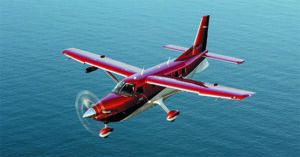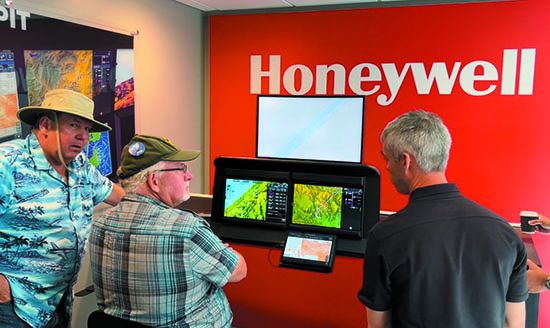Approximately 650,000 visitors, 803 vendors and over 10,000 aircraft made AirVenture 2022 at Oshkosh a record year. But the choked supply chain still has manufacturers scrambling for components to fill orders—everything from avionics to headsets to engines and accessories.
Still, the vibe was positive and there was plenty to see and we spotted a handful of good products worth talking about, including a new turboprop single unveiled on day one from Daher Kodiak. The FAA-certified Kodiak 900 isn’t a replacement for the successful Kodiak 100 outback turboprop, but instead an addition to the model lineup that also includes Daher’s TBM line of turboprop singles.
“The new model 900 combines Kodiak and TBM DNA and blends it into one airplane,” Daher’s Mark Brown told us. It’s all about speed—up to 35 knots faster than the Kodiak 100, spec’d at 210 knots true at 12,000 feet with a 969-NM range. It’s a hauler with an 8000-pound max takeoff weight and configurable seating for up to 10, including the pilot. The extra speed comes in part from new wheel pants (not installed on the 100), while the airplane is powered by a 900-HP Pratt PT6A-140A. The avionics are the Garmin G1000 NXi. Pricing is expected to be around $3.5 million when deliveries begin later this year.
For those a bit more budget conscious, PS Engineering (www.ps-engineering.com) was showing the $2595 PMA450C lower-cost audio panel. “We call this the inflation fighter because we took our top-of-the-line PMA450B panel and removed some of the functions that not everyone uses,” PS Engineering founder Mark Scheaeur said. This means fewer components, but it still retains three user-defined switched inputs, dual Bluetooth capability, a USB-C charging port and a simplified IntelliAudio Dimensional Sound feature, to name a few standouts. Look for a full review on the PMA450C in an upcoming issue of Aviation Consumer.
Over at the Aerox Aviation (www.aerox.com) booth, it was showing a prototype of the Boom Cannula. As the name describes, it is designed to attach to the earcup of a headset and is fully adjustable to solve the problem of comfort and cannula tubing management. Boom Cannula incorporates the oxygen delivery tubing into the boom, eliminating the tubing that generally runs over the ear and under the headset’s earcups. An imperfect headset earcup seal caused by over-the-ear canula tubing causes the ANR noise cancellation to be degraded. Boom Cannula is intended to resolve this problem. The oxygen tubing is neatly contained at the attachment point to the headset. The product is expected to sell for under $200 when it’s available later this year. We’ll keep tabs on it.
AirGizmos (www.AirGizmos.com) of Plano, Texas, has been best known for its iPad and portable GPS panel docks. This year, it was showing off the Gust Locks product. These are high visibility control locks designed to lock the flight surface, rather than (or in addition to) the control yoke inside the aircraft. This approach protects both the control surface as we’ll as the cabling, bellcranks and pulleys inside the aircraft during high winds. In fact, the Saturday before the show opened, a thunderstorm supercell went through Oshkosh with high winds, damaging a number of aircraft. Steve Ruzic of AirGizmos reported that all of the aircraft equipped with the Gust Locks did not sustain control surface damage. Gust Locks uses an innovative clamping system, using the “remove before flight” flag to tighten and loosen the locking mechanism, which can be turned 90 degrees. Gust Lock can be used on both metal and fabric control surfaces using this unique rotation feature. The hardware has silicon rubber to ensure that the paint, metal or fabric is not damaged during use. Gust Locks cost $39.95 each or $114.95 for a set of three.
SureFly (www.SureFly.aero) of Granbury, Texas, and Aithre Aviation (www.aithreaviation.com) of Port Orchard, Washington, have collaborated to create a solution to deal with an incapacitated pilot at altitude. The solution utilizes SureFly’s Descent, Aithre’s Angel and Garmin’s Smart Glide technologies to create a controlled descent to oxygen-richer altitudes. In a joint venture between SureFly and Aithre Aviation, the two companies have created a hardware and software solution, which leverages Garmin’s G3X Smart Glide technology (a name for the new product has yet to be created).

If a pilot becomes incapacitated or does not have the cognitive skills to fly the aircraft, a passenger can press the Aithre Angel smart button on the panel. Aithre Angel (a current and shipping product) includes the control hardware and the panel button, which, when pressed and held for three seconds, triggers Garmin’s Smart Glide using a discrete input pin on the Garmin stack. Think of it as a fancier alternative to the optional Garmin standalone plastic Smart Glide button. Aithre’s $250 button is brushed aluminum with a soft glowing LED that flashes when activated.

Aithre collaborating with SureFly sees a concept that activates the system automatically when a set of conditions are met and initiates a descent to 10,000 feet MSL by turning off the SureFly magnetos and activating Smart Glide. These conditions include: lack of pilot response or engagement, very low blood oxygen or very high cabin altitude. With Garmin Smart Glide initiated (by Aithre), the aircraft would navigate to the nearest airport. The concept would include continued attempts to communicate with the pilot and coach the pilot/copilot (using the Aithre Connect app). As a last resort, if the aircraft has reached the nearest airport and is circling overhead above the Minimum Sector Altitude (MSA), the new product would temporarily shut down the engine to initiate a block descent to MSA or 12,500 feet—whichever is lower. This is currently a concept while Aithre-SureFly explore the technology. Garmin’s Smart Glide will not descend the aircraft on its own under engine power (unless the aircraft is equipped with autothrottles or a low-pitch autopilot control), which would obviously be a preferred solution. However, there are many instances of hypoxia at the 15,000- to 21,000-foot MSL range where pilot incapacitation could be resolved prior to fuel starvation or terrain impact. Once the aircraft has reached the predetermined altitude, the SureFly magnetos would be turned back on, and with a windmilling prop, the engine would regain power. Currently there is no cost or delivery date on this concept; however, Aithre and SureFly will be testing the system and verifying safety over the next year.
Honeywell marches on with development of the Anthem integrated flight deck. The obvious first application would appear to be the Pilatus PC-12 NGX, since that is what Honeywell is using for flight testing, and the current PC-12 NGX has Honeywell’s Apex avionics. The challenge, however, is convincing aircraft OEMs that Anthem is a better fit than the current Garmin G1000/3000/5000 suites that dominate the market. Still, hats off to Honeywell for getting aggressive with Anthem’s development, and for other vendors that enthusiastically brought new concepts and products to the big show.


